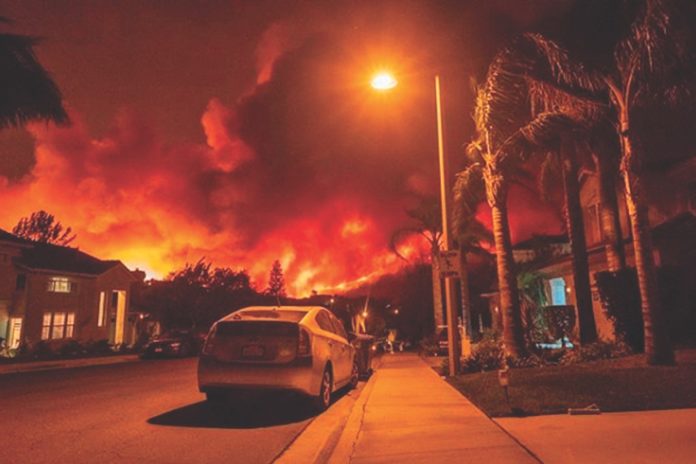Apartment and condo builders in some parts of the San Fernando Valley may have to use fire-resistant materials if a nascent movement takes hold.
Opponents have said such new rules, if approved, would lead to much higher construction costs. Supporters dispute that, and say the real impetus is to create a safer, more fire-resistant city.
At issue is an ordinance proposed in June 2019 – following the November 2018 Woolsey fire in west San Fernando Valley and in Ventura County that destroyed 1,600 structures, killed three and prompted nearly 300,000 people to evacuate. Proposed by Valley city councilmembers Bob Blumenfield and Monica Rodriguez and titled “Building a Safer Los Angeles,” it would expand what’s called Fire District 1 and require that multifamily homes within that district be built with noncombustible materials. The ordinance was approved in June by the council’s Public Safety Committee and will go to the Planning and Land Use Committee.
Fire District 1 includes Van Nuys and several other areas, including downtown Los Angeles, Westwood, Venice and Hollywood. There are provisions that require fire-resistant construction in the district such as openings that must be protected by a fire assembly with a 45-minute fire resistive rating and roofs that must be built using fire-retardant materials.
The measure proposes that the city council expand this protected zone to include all areas within the city of Los Angeles covered by the California Department of Forestry and Fire Protection’s very high fire-severity zone and high-wind velocity zone, as well as areas with a population density of at least 5,000 residents per square mile.
Those expanded areas would include Woodland Hills, Studio City and pretty much any portion of Los Angeles near hills.
Building with wood would be severely curtailed in the new district. There are five construction types, I through V, with types I and II requiring the use of concrete or steel, while types III through V use different types of wood. This motion calls for construction types IV and V to be prohibited within the expanded fire district.
Cost a factor?
Resistance has come from the construction industry because of the higher costs, or at least the perception of them.
Daniel Garay, environmental health and safety manager at construction company Suffolks, which has an L.A. office downtown, said that whether a building is made with concrete or wood, both are still held to equally high safety standards.
“When we build a building, there’s a certain fire-safety factor that has to be taken into consideration at the end, and I don’t believe that the fire department loosens up their standards based on if it’s wood or concrete,” Garay said.
He added that construction using noncombustible materials would not only be more costly, but also slow down the process.
“Concrete and cement are not infinite resources the way people think. As a matter of fact, we have concrete shortages on a regular basis (and) concrete is significantly more expensive,” Garay added.
“When you’re talking about low-income housing … it might mean some projects may never leave the ground. If we’re having a housing crisis and you’re trying to talk about, ‘Hey, we’re going to go ahead and develop this land,’ it will never get off the ground based on cost, resources and availability.”
However, Gregg Lewis, an architect and chief communications officer at the National Ready Mixed Concrete Association, said he believes building codes need to be improved for safety.
“Unfortunately, I think that there are a lot of cases where decisions have been made in the development of codes that haven’t necessarily resulted in the safest-possible buildings available, in particular where we’re talking about high-density housing,” Lewis said.
“We’ve got the same issues all over the country where apartment fires, senior housing facilities, student housing, all of these kinds of affordable housing have resulted in disasters where they could have been prevented.”
City letter
A letter addressed to the city’s Public Safety Committee from the Departments of Building and Safety, Fire Department and City Planning, with the assistance of the city attorney, states that the building safety department “contends that existing Los Angeles Building Code provisions provide adequate safeguards to ensure that responsible construction practices are utilized for new multifamily and commercial structures in Fire District 1 and has no further recommendations.”
That letter added that the overall construction and materials cost of building a four-story multifamily residential apartment would increase between 10% to 43%, depending on the type of construction chosen.
On the other hand, Steve Crosby, senior advisor at Build with Strength, a group that supports the ordinance, differs. Using cost-estimation data from construction industry analyst company RSMeans, the organization said that a four-story apartment building in Los Angeles made of concrete would be 0.06% more expensive than one made with wood framing.
“Of course, commodity prices go up and down all the time, but on par, it’s the same cost within basically inches,” Crosby said. “Sometimes it’s a lot more cost-effective. Other times it’s equal. We’ve shown using the data that developers use to figure out the cost, that it’s really on par. Los Angeles clearly needs to build housing, but as I said, it has to be done correctly.”
